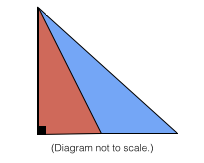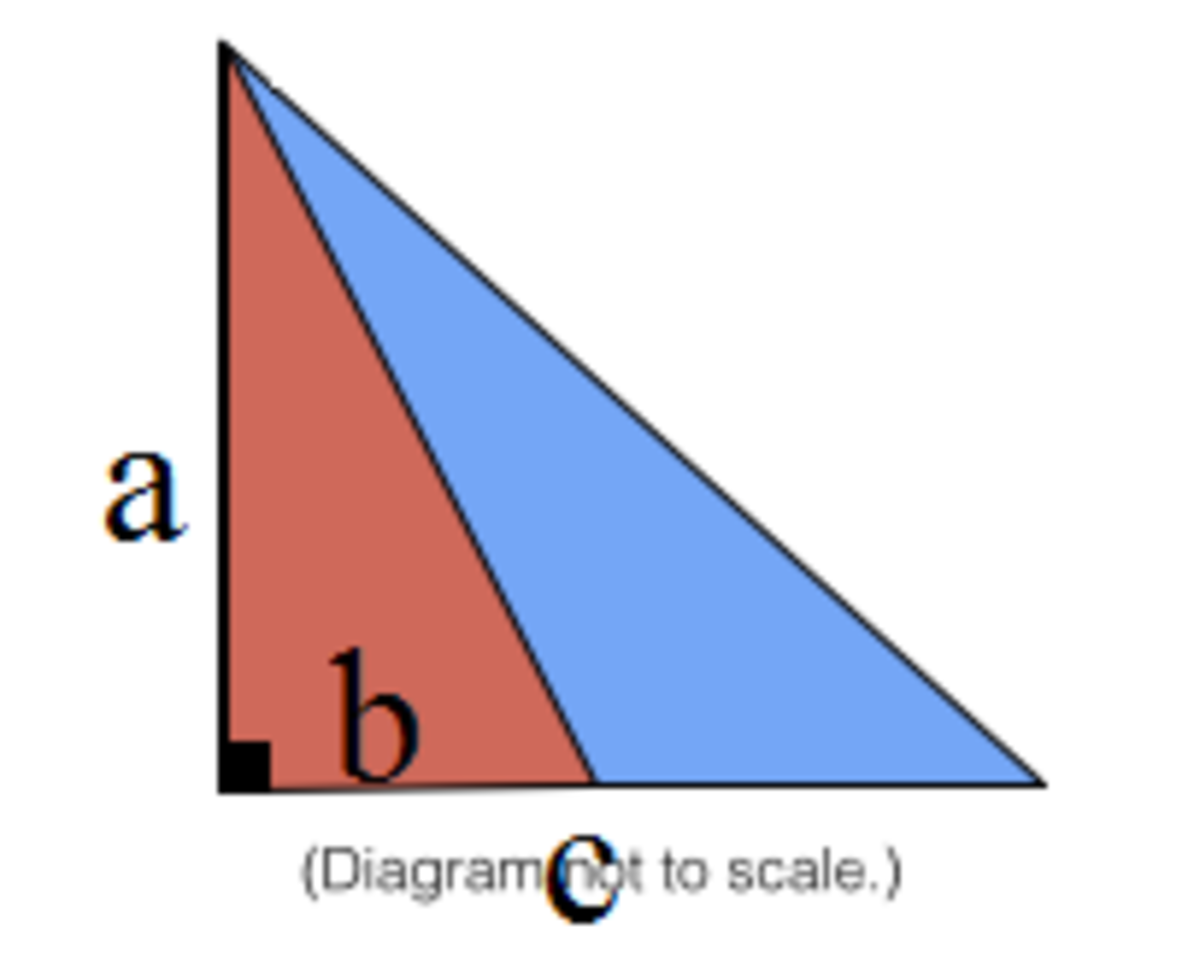Similar Right Triangles
 In the large right triangle above, an angle bisector is drawn such that the red triangle is similar to the large right triangle. What is the ratio of the red area to the blue area?
In the large right triangle above, an angle bisector is drawn such that the red triangle is similar to the large right triangle. What is the ratio of the red area to the blue area?
This section requires Javascript.
You are seeing this because something didn't load right. We suggest you, (a) try
refreshing the page, (b) enabling javascript if it is disabled on your browser and,
finally, (c)
loading the
non-javascript version of this page
. We're sorry about the hassle.
3 solutions
I was confused by your question, which was talking about ratio of AREAS 1 and 2. So my answer was (1:2)^2 = 1:4. Since I couldn't find 1:4 among the choices of answers, I took a chance to answer 1:3 (about which I was almost sure that it would be wrong... I should have tried 1:2...). So I think that you should add a precision specifying that we're looking for the basic ratio of the sides, not the ratio of the areas. Otherwise this is a nice problem with an elegant solution. Thank you for your attention.
Log in to reply
The heights of the red and blue triangles are the same, so the ratio of their areas will be the same as the ratio of their base lengths, which comes out to 1 : 2 .
Log in to reply
I mean AREA = (b.h)/2. Base multiplied by height, divided by 2. Since base is multiplied by the height, the ratio of areas is equal to the square of the basic ratio (or "sides" ratio). It is the same for any plane figure. So here (1/2)^2 = 1/4. For intance, see http://www.mathopenref.com/similartrianglesareas.html Regards.
Log in to reply
@Louis-Marie Gaulin – Yes, I realize that, but since the height h is the same for both the red and blue triangles the ratio of their areas will be identical to that of their base lengths. The red and blue triangles are not similar, so the "squaring" approach you describe does not apply when comparing their areas. The two similar triangles are the red and the large right triangle, (which is composed of both the red and blue triangles). The ratio of their (similar) side lengths is 1 : 3 , so due to their similarity the ratio of their areas will be ( 1 / 3 ) 2 = 1 / 3 , as your method would indicate. Regards.
Log in to reply
@Brian Charlesworth – Yes. The blue and red areas are not similar. You are absolutely right. Thank you! :)
@Brian Charlesworth – I would suggest another conclusion for the demo (and simpler, I think). From the second and third paragraphs of the demo, it is proved that the apex angle of the blue triangle measures x=30°. Let's call c and d the two sides of the other apex angle, in the big right triangle. Thus we have sin x = sin 30° = c:d = 1:2. Finally, by the triangle angle bisector's theorem (applied to the big right triangle), we have a:(b-a)=c:d, or a:(b-a)=1:2. Regards.
Log in to reply
@Louis-Marie Gaulin – Great! That is much simpler indeed. Thanks for reminding me of that theorem. :)
Once I realized that the red triangle was a 30-60-90 (making the lower right blue angle a 30 deg angle) I used the 1 : 3 : 2 property of 30-60-90 triangles, and that the blue triangle was necessarily then isosceles, to determine that the base of the blue triangle must equal the hypotenuse of the red triangle, and was therefore twice the base of the red triangle. (Clearly, the base of the red triangle corresponded to the "1" in the side lengths.)
How did I decide that we were working with 30-60-90 triangles? Because half the top angle of the large triangle had to equal the bottom right blue angle, and the bottom right red angle, then, had to be double the top red angle. That only works with a 30-60-90.
 Solution For red triangle let height be 'a' and base be b and for larger triangle bace be c. Triangles are similar b/a = a/c a2 = bc
a2 + b2 = (c – b)2 Blue triangle is isosceles.
= c2 – 2cb + b2 Putting a2 = bc
Solution For red triangle let height be 'a' and base be b and for larger triangle bace be c. Triangles are similar b/a = a/c a2 = bc
a2 + b2 = (c – b)2 Blue triangle is isosceles.
= c2 – 2cb + b2 Putting a2 = bc
c =3b
Height of both triangles is same so ratio of area is ratio of bases hence Ratio b / (c-b) 1:2
As the red triangle is similar to the large right triangle, its apex angle x is the same as the lower right angle of the large right triangle, (and thus also of the blue triangle).
The lower right angle of the red triangle is thus 9 0 ∘ − x , and so the obtuse angle of the blue triangle is 1 8 0 ∘ − ( 9 0 ∘ − x ) = 9 0 ∘ + x . Since the apex angle of the blue triangle is x we have that
x + ( 9 0 ∘ + x ) + x = 1 8 0 ∘ ⟹ 3 x = 9 0 ∘ ⟹ x = 3 0 ∘ .
The apex angle of the large right triangle is then 6 0 ∘ . Now let a be the length of the base of the red triangle, b be the length of the base of the large right triangle and h the common height of both of these triangles. Then we have that
tan ( 3 0 ∘ ) = h a and tan ( 6 0 ∘ ) = h b ⟹ a = h tan ( 3 0 ∘ ) = 3 h and b = h tan ( 6 0 ∘ ) = h ∗ 3 .
The base length of the blue triangle is b − a = h ∗ ( 3 − 3 1 ) = h ∗ 3 2 .
Since the red and blue triangles have the same heights, the ratio of their areas will be the same as the ratio of their base lengths, which is
b − a a = 3 2 h 3 h = 2 1 , and so the desired ratio is 1 : 2 .